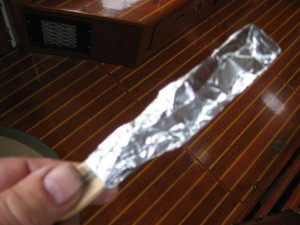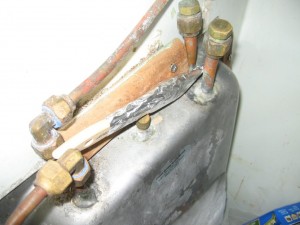Good varnishing brushes are definitely not cheap! The quickest way to ruin one is to let varnish dry in the brush – not something any of us wants to do.
But cleaning a brush is not an easy task. You may think that after triple-rinsing it in fresh paint thinner, the brush is clean. But put it away for a couple of days, and when you go to use it next, the bristles are disappointingly stiff.
As a Chemical Engineer, I learned several things that have made brush cleaning a lot easier. (What? Practical knowledge? Who knew?):
- Use a counter-current wash system. This keeps the clean end of the system separate from the contaminated end. In a real chemical plant (for example, an alumina refinery) there would be as many as 10 stages or more. Here we will make it simple – we’ll use only two. Do it like this:
- Save an empty paint thinner container. When you rinse out your brush, dump the now-contaminated solvent into this container. Soon you will have lots in there. As soon as you have enough, this is now your stage 1 rinse. Squeeze out all the varnish you can from the brush, and then clean it thoroughly in the stage 1 rinse solution. Squeeze out all the stage 1 rinse, and wipe the brush on a rag, trying to absorb as much of the stage 1 rinse as possible. Dump the stage 1 rinse back into the stage 1 container.
- Next, rinse the brush in 3 small changes of clean solvent. As above, drain all the now contaminated fresh solvent into the stage 1 rinse container, wiping the brush nearly dry between rinses.
This works because even tho the stage 1 rinse is not pure solvent, it is not very far from it, as compared to the varnish itself. Then the pure solvent is only used to rinse out the stage 1 solvent – not raw varnish. There is a secondary effect: some of the varnish (and paint, and stain, and…) precipitates out in the stage 1 rinse container. When it does so, the stage 1 rinse liquid becomes less contaminated. By doing things this way, your use of fresh solvent will go down considerably, even while your brush gets cleaner.
- Exclude one of the reactants, and a chemical reaction will stop. Curing paint or varnish is a chemical reaction between the resins in the varnish and the oxygen in the air (and water vapor, if there are urethane resins involved). Exclude air, and the reactions stop. This is why varnish does not cure in the can.
- Reaction rates roughly double with every 10° rise in temperature. For our purposes here, the converse is the more valuable: reactions rates are halved for every 10° drop in temperature.
Putting these things to work, on a day when I just need to preserve the brush for tomorrow, I give it a quick but thorough rinse in the stage 1 solvent, getting most of the varnish out of the brush, and then wipe it mostly dry on a rag.
Next, I tightly wrap the brush in aluminum foil – this excludes air and water vapor.
Finally, I store the brush on top of one of the holding plates in our freezer.
I really have no idea how long this process will preserve a brush, but I can set a lower limit. I have pulled a brush out of the freezer (I forgot it was in there) after a month, and it was still pliable, ready to use.
for more articles by Bob please visit http://windborneinpugetsound.blogspot.com/



Good advice here, I personally NEVER leave any varnish till the next day on a brush.
I use a small amount of thinners (not the new environmental stuff, it really is terrible!)
Each time you push the brush into the thinners with downward strokes turn the brush every 2- 30 seconds and push on a different part of the brush bending the bristles slightly.Do this vigorously. I repeat this 3 times discarding the small amount of thinners into a scrap bucket each time.
Never Ever use water on a china bristle brush it will swell and lose your chisel edge.
You can however buy a Chinex brush which is a synthetic bristle brush..and these can be washed in water after being cleaned with thinners, as a painter of 39 years i can say they are not bad brushes.
1 trick I can tell you that most painters do not do is to wire brush the clean brush before you use it the next time. Feel the brush the next day by flexing it in your hand, then wire brush it by pushing the bristles away from the ferule(the metal part)
You will feel the difference immediately a softer brush !!
Do this to all your brush work before you start a project.
Martin..SV “Sea Pirate”
Those are some good tips… I have to admit to being bad about caring for my brushes and it is pretty expensive in the long run. Taking care of good brushes will cost less in the long run and give you better quality brushes 🙂